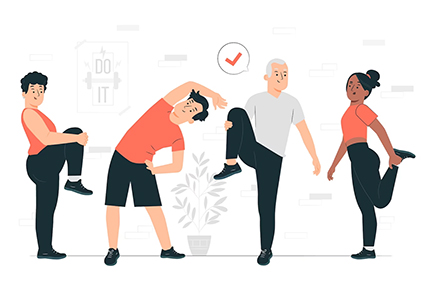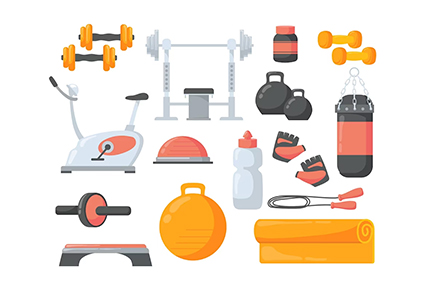
Ignoring exercise later in life can have big repercussions in terms of a person’s physical health, increasing the likelihood of health problems and back trouble. Even a small amount of daily exercise is enough to avoid spine issues, ensuring older people can continue to lead an active lifestyle.
In this article, we will discuss how older adults can get started with exercise and why it’s important.
Why Exercise is Important for Older Adults
For older adults, middle-aged people, and senior citizens there are five key benefits of exercising on a regular basis.
Preventing Diseases
Studies across the world have shown that regular exercise and physical activity can prevent an array of common diseases, including heart disease, diabetes, degenerative disc disease, and even cancer. This is because exercise helps to build a person’s immune system. This is especially important for older people as immune systems can weaken over the years. Even gentle exercise each morning such as a brisk walk can help to prevent illness.
Better Cognitive Function
Exercise improves a person’s motor skills which benefits their overall cognitive function. Studies show that improved cognitive function can help reduce the risk of dementia, and exercise is one of the best ways to improve these functions. Even if you are new to exercise, it is better late than never, and the rewards can be significant.
Improved Mental Health
Exercise releases endorphins in the body which are a hormone that makes a person feel good. These hormones reduce stress levels and maintain a person’s overall happiness, reducing the chance of a mental health disorder developing. Not only this but better well-being and state of mind also promote better sleep, so exercise is highly recommended for anyone who suffers from insomnia. Poor sleep and stress are also common causes of back pain.
Strength and Flexibility
Exercise makes a person stronger and more flexible, this, in turn, improves balance and coordination, decreasing the risk of falls or injuries when lifting objects, for example. Such an injury can have a big impact on an older person’s quality of life, preventing them from being active, and potentially requiring surgery.
Senior citizens in particular can take a long time to recover from a bad fall, so measures should be taken to avoid this type of incident.
Exercise is Social
Exercise can be very social, whether you are joining a local walking group, a spinning class, or taking part in a team sport. There is no reason why exercise can’t be fun, and social engagement is one of the main reasons people persevere with exercise even though they may find it difficult at first. For older people, creating these social bonds can be invaluable, especially for people who are prone to feeling lonely or depressed.
How to Get Started with Exercise
Regardless of a person’s age, getting started with regular exercise isn’t easy, especially if you are slightly out of shape or overweight. Sometimes the motivation might be lacking, or you may feel like giving up part way through but with time, exercise will get easier, and maybe even become enjoyable.
In this section, we will discuss what steps an older adult needs to take to get started with exercise.
Determine Your Fitness Level
It is likely that you will have a rough idea of your current fitness level and what your limits are when it comes to exercise. However, it is a good idea to establish a baseline before beginning, so you can check your progress as the months pass by.
To do this, you can check your pulse rate after walking 1 mile, time how long it takes to walk 1 mile, count how many push-ups you can do in one session, see how far you can reach forward when sitting with your legs in front of you, and measure your waist circumference.
Create a Fitness Plan
When creating a fitness plan there are a number of considerations that can make your life easier.
First of all, you should consider the overall goal of the exercise, whether it is to lose weight or strengthen your core, for example. Secondly, it is important to create a balanced and achievable routine that allows you to increase the repetitions easily over time - starting with a low amount and progressing as and when you feel comfortable.
You should try to include as many different activities as possible to ensure every part of your body is being worked. To make things more enjoyable you could also tie in activities while exercising, such as listening to an audiobook while running, or watching TV when using the exercise bike.
When you feel ready you can try a few high-intensity training routines to test your limits, but always remember to plan rest days so your body can recover fully.
 Monitor Your Progress
Monitor Your Progress
Now your plan is in place and you’ve followed it for a number of weeks, it is time to monitor your progress and determine how you can step up your training routine. It is recommended to assess your fitness level every six weeks in the beginning, then every three months once you have been exercising for over six months.
This will allow you to adjust your fitness plan for better results. Are the results minimal or are you seeing no change? Then you need to increase the intensity or exercise more often. Do you find some exercises boring? Then swap them out and research different exercises that are more appealing.
Over time you will create a plan that you enjoy and can deliver real results that can drastically improve your mental and physical health.
The Consequences of a Lack of Exercise: Severe Back Conditions
Spine weakness caused by a lack of muscle strength or carrying too much weight can result in various conditions such as a herniated disc, stenosis, or degenerative disc disease. This can result in severe pain and prevent a person from performing certain actions - impacting their quality of life. This is why it’s important to learn how to strengthen your lower back before you develop complications.
If a condition such as spinal stenosis or spondylolisthesis shows no sign of improvement then a person may require surgery such as a laminectomy, spinal fusion, or a spinal implant like the Premia Spine TOPS System.
This is why exercise is vitally important when it comes to protecting your spine and ensuring you are as healthy as possible later in life.
Thank you for reading. We hope you have found this article useful.
Disclaimer
This content is for informational purposes only and is not meant to replace the guidance of your licensed healthcare practitioner. Statements on this website have not been evaluated by the Food and Drug Administration. Information and products are meant for general use only and are not intended to diagnose, cure, treat, or prevent any disease or provide medical advice. Any decision to use supplements or medical or non-medical procedures to support your specific needs should be considered in partnership with your licensed healthcare practitioner. Any questions you may have concerning your use of drugs, medications, supplements, or medical or non-medical procedures should be directed to your healthcare provider. Publication of this article does not indicate an endorsement by SeniorLiving.com.
